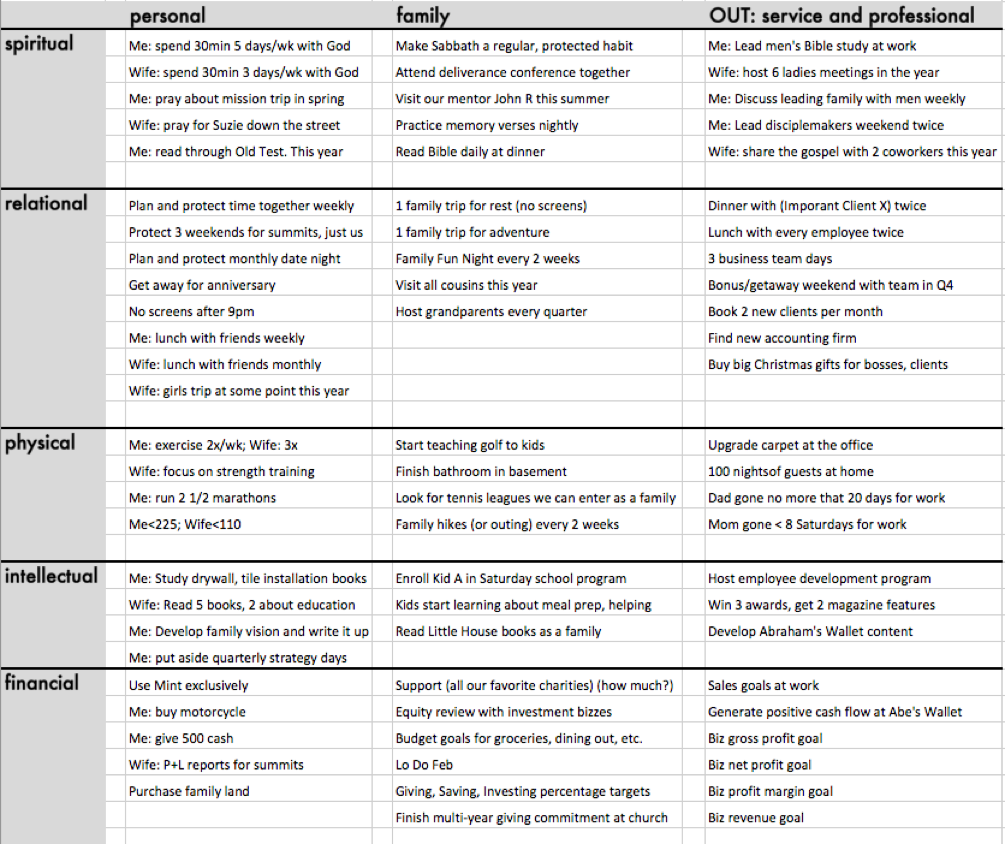
This article is part 3 of a 4-part series about having your own Goals Summit every year. Here’s links to parts 1, 2, and 4.
Okay: you understand the point of having a Summit and you get the 5 capitals. But how do you actually pull this thing off? Let’s discuss, shall we?
THE SET UP
I strongly recommend protecting 2 days, at least, to make your first summit a success. (Mrs. Wallet and I have upped the ante to 4 days in the last couple of years, for reasons I’ll explain in Part 4… and because it’s one of our favorite times together all year.) Get a night at a hotel or somewhere you can be left alone. Protected time is key (for this reason, a “quiet night at home” is workable, I guess, but not what we’re looking for; you need to be away from all distractions and doing the dishes shouldn’t even be a possibility). You’ll need time and brain space to really consider major life decisions: Is it time for that third child? Should we invest in that friend’s business? Maybe it’s time to move jobs, after all… When else, pray tell, are you going to have the margin and bandwidth to ask such big picture questions?
THE CONTENT
We recommend you download our handy dandy Goals Summit Guide, which will walk you through all these steps in detail. But whether you do or don’t here are the broad strokes of the Summit, with a bit of explanation thrown in there:
1- REVIEW.
a. We ask ourselves “What happened last year?” and give our calendar (and bank statements) a thorough once-over. We simply jot down anything notable (“Boy, we spent a lot at the doctor this year.” “You were out of town for 20 days on business this year… that was too much.” “We made it through 3 different family crises! Thank God!”) and summarize the year (think through the 5 capitals as you do this). Who was important to us? Who built into us the most? Where was our time best invested? Where were we spiritually grown the most? What were our financial wins and losses? What gave us the most energy? Did the exercise schedule work? When were we the most rested? Etc. Just compile what happened, analyze it, and look for trends. Then:
b. Compare those with your goals sheet from last year, if you’ve got one. Again, note trends. Learn your family’s capabilities and rhythms (“We had the boys in too many sports last year. That was painful.” “We’ve got to protect your monthly lunches with your buddies; those bring you so much life.” Etc.) Once these observations have been made…
c. Stop for gratitude and worship! This is one of my favorite parts of the whole Summit, and it happens just a couple of hours after we start. My wife and I just have a time of prayer over this whole last year, noting in detail how our Father has cared for us, provided for us, protected us, and planted in us over the last year. So much entrusted to us! So much patience for our thick-headedness! So much mercy enjoyed by us! Just allow yourselves to gush in admiration and adoration of a God Who loves to give good gifts to children like you. What a wonderful Father He is.
2- DREAM. After the review (and a break!), you can give yourself a head start on goal planning by simply going back through your review list (and/or goals) and asking “Which of these things to we expect God to continue or expand on?” That’s a great reference for where you’re headed. If you’ve got a fledgling discipleship relationship, for instance, where you’ve seen good early returns, you can probably expect God to expand that in the coming year. Circle those things that you expect to see going forward. Then ask some big questions that will help your planning aim be as accurate as possible:
a. What should we STOP doing?
b. What should we maintain, because it’s so good?
c. What should we START doing?
d. If we had to guess at THIS MINUTE, how could we summarize our family vision? (We have much to say about family vision, but don’t get too fancy on this one. Just describe your main objective or goal for the coming year, as you sense it. “Figure out homeschooling and get it started.” “Nurture our new baby and figure out rhythms in this re-invented family.” “Excel in the new business while keeping our rhythms of rest and recreation in place.” Those are all fair.)
e. What patterns should we try to make happen as a couple, a family, and a larger community?
f. Who are our Pauls (people who’ll lead us), Timothys (people we’ll lead) and Barnabases (people who’ll walk beside us)?
g. What does my spouse most need from me in this next year? (Might be a good time for some apologies and repentance…!)*
3- PLAN. Now we’re ready to get very practical. You’ve got a good idea of where your family is (are we exhausted, so rest is crucial right now? Do we need a new challenge? Is it time to take new ground? Or is just maintaining last year a good goal?), and a growing list of hopes and some goals in there too. Well heck, let’s formalize this puppy!
a. It’s at this point that I pull out my spreadsheet, which is a table with PERSONAL, FAMILY, and OUT at the top (these topics are covered in part 1 of this series), and THE FIVE CAPITALS running down the left side (these are covered in part 2). I make sure that everything we’ve dreamed about above is captured somewhere (…and don’t get too fussy about where stuff belongs. Is “having a weekly lunch with my 12 year old son” a personal relational goal, or a family financial goal? …uh, who cares. Just get it down there), and that every box has at least something in there. Again, here’s an example list:

b. Once we have that list, I pull out a blank year-long calendar and start populating it. This is so fun to me! I get to dream about which conferences my wife and I will attend, where our vacations and spiritual trips will be, when our 3 summits will be (we make our anniversary overnight one of our summits, btw), protect Passover and Sukkot and all the great annual rhythms we’ve come to love. (BTW, if Spiritual Capital is most important, it should be your FIRST consideration in your year. Then relational capital, then physical capital, etc.)
c. (Stay with me we’re nearing the finish line.) Then I pull out a blank weekly planner and we talk through what a “normal” week would look like. Populate this just like the annual calendar: with spiritual capital first. That means protecting your Shabbat, quiet times, and any non-Shabbat spiritual training you’re doing for yourselves or the children. Then move on to relational capital… if you plan your week this way, your paid work will NOT run your life and family. Hallelujah! (If you didn’t know, this is a major, major flaw of the American Dream Life. It ends in destruction: divorce, addiction, greed, burnout, and isolation. F that.)
4- Lastly, CONSECRATE. (As you might guess, I also love this.) Once we have these precious docs in front of us, these fragile, hatchling hopes and goals and possibilities, that represent our dearest dreams for our home over the next year… we hand it all to Yehoveh. We make our plans but it’s HIM Who directs our steps. We ask that He’d give us the grace to see every one of these things to completion that pleases Him… and that everything that would displease Him would be frustrated, and would fail and fall away. Everything is laid before our Loving Master. And we boldly and earnestly ask for blessing! May we do even better financially than we’re planning! May we have even more impact in service! May we hit our physical goals and then some! But we humble ourselves before God and ask for His blessing and guidance by His Spirit as we start to walk these plans out.
THE WIN
Most people will never do anything like what I’m describing above. And maybe, especially on your first attempt, this is too much to try to bite off. Maybe you do a stripped-down version of this and see what kind of fruit it yields. This should be EXCITING to you and should feel like a RELEASE into the kind of planning that most of us long for and talk around but never really nail down. It shouldn’t be burdensome… this is your dream life for crying out loud!
The win, more than anything, is that you’ve provided your marriage with a forum for talking about everything that matters to your future. And you’re on the same page! Even if you only got like 5 goals established, hey—FIVE GOALS! And hopefully you took the time to really listen to each other’s needs and hopes, tailor your own expectations, and support each other in the most important work you’ll ever do… creating a home and family oriented around the LORD and what He’s put in each of your hearts. A family run this way is set up to prosper, to make disciples, and to receive more of God Himself! Boy oh boy!
This post is the tactical and content side of what we accomplish on our Year End Goals Summit… but it doesn’t tell you the nitty gritty of HOW we do it (teaser: we do it in style!). For that, you’ll need to check out Part 4.
[*I acknowledged him already, but I have to say again that many if not all of these helpful, probing questions come straight from Brandon Schaeffer, of Five Capitals. He gave my wife and I business and family coaching for years and was a massive help to us getting intentional.]






